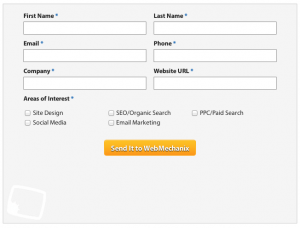
Quick, Easy, & Free Web Analytics Audit Checklist
Our team put together an abbreviated site audit checklist that will provide you a quick and easy way to see whether or not your website could benefit from some optimization.
So, if you are ready to make the most of your online presence, pull up a chair and get ready to follow along! We’re going to you walk you through the checklist, item by item.
1. Do you have Google Analytics installed?
The first item on the site audit checklist is to see if you have Google Analytics installed.
Google Analytics is a web tracking tool that allows you to see what traffic your website is getting and what users are doing once they reach your website. Using it for your site is critical because you always want to be able to track your marketing efforts and determine if it’s generating ROI.
In order to see if you have Google Analytics installed, you want to so the following:
- Go to any page on your website (ideally the homepage, but any page will do)
- Right click
- Click “View Page Source” in the menu
- Use the find function (Command + F for Macs and CTRL + F for PC’s) and search for “Analytics”
If you find code that looks like the code to the below, then you’re good to go!

If not, you definitely want to make your way to www.google.com/analytics to set up an account and get Google’s step-by-step instructions to install the code as soon as possible!
As far as SEO is concerned, you ought to have some web analytics system installed before you even begin considering an SEO strategy. It’s very important to see how much traffic your site is getting and how your visitors are engaging with your website before you start tweaking things.
Your website could be well optimized and performing at an already high level, but you would have a very difficult time improving if you’re unable to measure your efforts and use the data to make decisions!
2. Do you have a logo linked to the homepage in the header of the website?
Think about it – if you’re on a website and you get a few pages in, you don’t want to have to hit the back button 5+ times in order to get back to the homepage, do you? Of course not!
This not only helps branding and usability, but it’s also important for internal linking, which is a noteworthy aspect of SEO.
Google gauges the reputability of a page based on a number of factors, most important of which are content and links – both internal and external. For the sake of time, we’ll focus here only on the idea behind using internal linking as a reputation metric.

If a page has no links from other pages on its own site, that makes it difficult for Google to find and crawl that page regularly. Additionally, it seems to indicate that the content is unrelated or unimportant to anything else on the site because there was no reason to link to it from other pages. Either way, a lack of internal links to a page tells Google that this page may not be worthy of a high rank in the search results.
3. Do you have your phone number clearly displayed at the top of the site?
The logic is simple — prospective customers and clients will be less likely to call you if they can’t find your phone number.
If you put your phone number in the upper right hand corner of the website in a big, bold font, people won’t be able to miss it!
Note: If you really want to be super-awesome with tracking, you can sign up for a call-tracking service, which will allow you to determine which leads called you as a result of your website.
It will even break it down so you can see which of those leads came to your site directly, via organic, or via paid search, and even allows you to see what terms the user specifically searched.
4. Do you have any forms on your site?
The last item on our quick and easy site audit checklist is having forms on your website.
When you’re operating a business website, the entire point is to encourage people to contact you so they can buy your product or service. However, if you don’t have any forms on your site – or any other way to contact you – you are making things inconvenient for the user and, as a result, they’re probably going to take their business somewhere else.
You might be asking yourself, “Well, what about the phone number at the top you just told me I should have? Isn’t that enough?” In a word – no.

The reason people use the Internet so much is because of the convenience factor. If your website doesn’t make it easy for users to accomplish what they’re trying to accomplish, they’re going to quickly move on.
Want a real site audit?
We understand that this wasn’t the longest site audit checklist, so if you want to talk to us about conducting a comprehensive site audit, email us at [email protected].
We also raffle off free site audits on occasion that we let people know about via email newsletter, so be sure to sign up for our email newsletter so you can be among the first to know when the next raffle comes up!
Most newsletters suck...
So while we technically have to call this a daily newsletter so people know what it is, it's anything but.
You won't find any 'industry standards' or 'guru best practices' here - only the real stuff that actually moves the needle.







